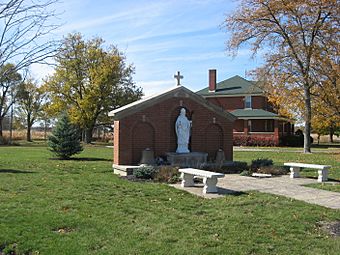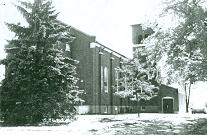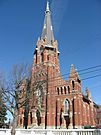St. Patrick's Catholic Church (St. Patrick, Ohio) facts for kids
Quick facts for kids |
|
|
St. Patrick Catholic Church and Rectory
|
|

Memorial on the site of St. Patrick's Church
|
|
| Location | Hoying and Wright-Puthoff Rds., St. Patrick, Ohio |
|---|---|
| Area | Less than 1 acre (0.40 ha) |
| Built | 1915 |
| Architect | Louis Ley |
| Architectural style | Italianate |
| MPS | Cross-Tipped Churches of Ohio TR |
| NRHP reference No. | 79002836 |
| Added to NRHP | July 26, 1979 |
St. Patrick's Catholic Church was a historic church building in a small community called St. Patrick, located in western Ohio, United States. It was part of Shelby County and sat at the corner of Hoying and Wright-Puthoff Roads. The church was an important landmark in this rural area for many years.
Contents
The Church's Story
How the Parish Started
The St. Patrick church community, also known as a parish, began in 1862. Most of the first members were Irish workers. Even though many farmers in the area were German, the people who started St. Patrick's were often laborers. They had come to the area to help build the Miami and Erie Canal. This canal was a big waterway that helped transport goods across western Shelby County.
Starting in 1863, priests from a group called the Missionaries of the Precious Blood served the parish. These priests lived in a town called Minster, which was about five miles away.
Early Church Buildings
The first church building for the St. Patrick parish was made of logs and was built in 1863. Logs are tree trunks that have been cut and shaped. Later, in 1871, a new church made of wood frames replaced the log building.
In 1882, some members who lived closer to McCartyville formed their own separate church community. This meant fewer members for the original St. Patrick parish.
Church Design and Style
By the 1910s, the wooden church building was getting too old and small for the growing community. So, the parish decided to build a new, larger church. This third and final church was made of brick in a style called Italianate. This style often includes features like wide eaves and tall, narrow windows.
The church had a strong concrete foundation and a roof with a pointed top, called a gable roof, covered in tiles. It was a rectangular building with a square bell tower on one corner. Inside, the church had beautiful paintings on the walls and ceilings, called frescoes. There was also a special statue of Saint Patrick, who is the patron saint of Ireland. Sunlight shone into the church through many colorful stained glass windows.
The Land of the Cross-Tipped Churches
St. Patrick's Church was one of many large churches built in rural areas of western Ohio. These churches were often served by the same group of priests. This region is known as the "Land of the Cross-Tipped Churches" because many of these churches have tall steeples with crosses on top. While most of these churches were built in the Gothic Revival style, St. Patrick's was one of the few that had a different look and did not have a very tall steeple.
Other Buildings in the Community
Besides the church, the St. Patrick parish owned three other important properties in the community:
- Cemetery: To the east of the church was the parish cemetery, where people from the community were buried.
- School: Across Hoying Road, to the north, was the old parish school, built in 1906.
- Rectory: To the east of the church was the brick rectory. This was a two-story building with a hip roof (a roof that slopes on all four sides) and a stone foundation. The parish built the rectory in 1919 to be a home for its priest. Before this, the priests serving St. Patrick's lived at St. Michael's Church in Fort Loramie.
What Happened to the Church
In 1977, the church and rectory were studied as part of the Ohio Historic Inventory. This was done to see if they should be protected as historic buildings. Both buildings were found to be in good condition.
Two years later, in 1979, both the church and the rectory were officially added to the National Register of Historic Places. This is a list of places in the United States that are important to history. More than thirty other churches in the "Land of the Cross-Tipped Churches" were also added to this list at the same time.
At that time, people were worried that some of these rural churches might be in danger because fewer people were living in the countryside. While most of the other churches on the list are still active today, St. Patrick's Church has since closed. Although the parish was still operating in 1996, it is no longer listed by the Archdiocese of Cincinnati. The church building itself has been taken down. Today, a small memorial stands where the church used to be, but the rectory building is still there.





